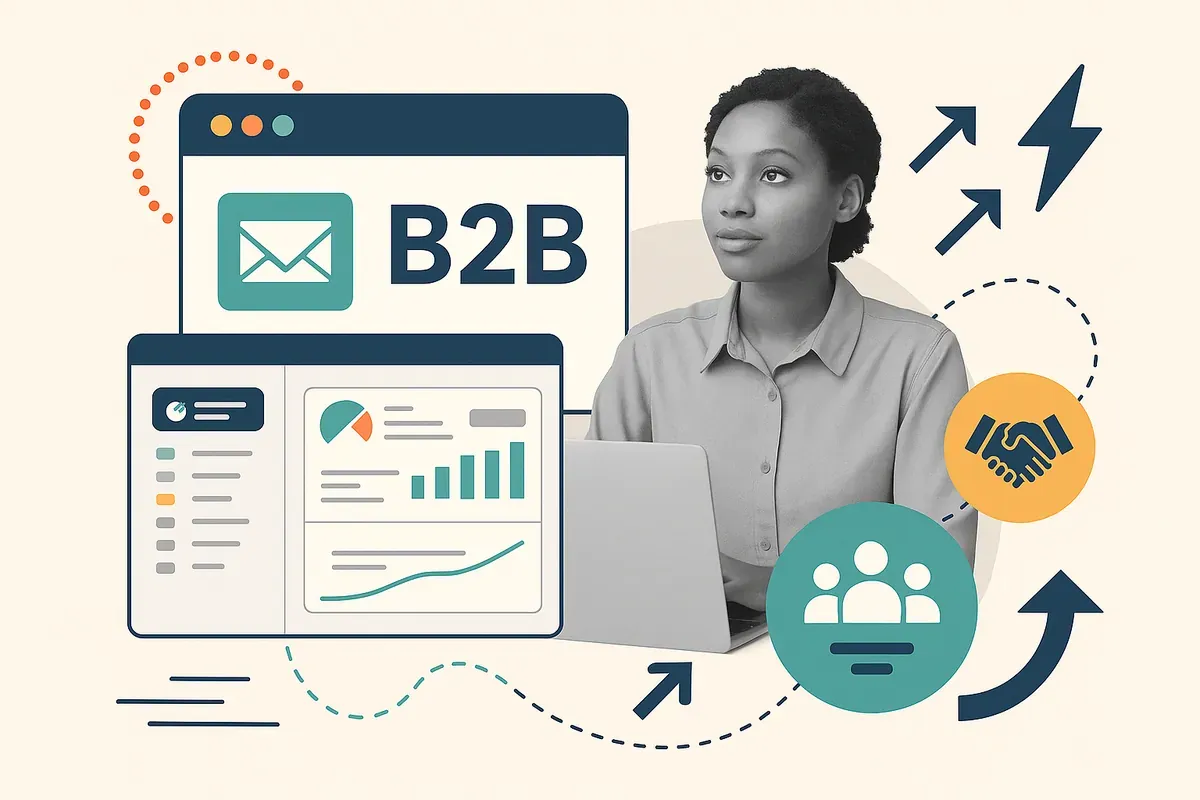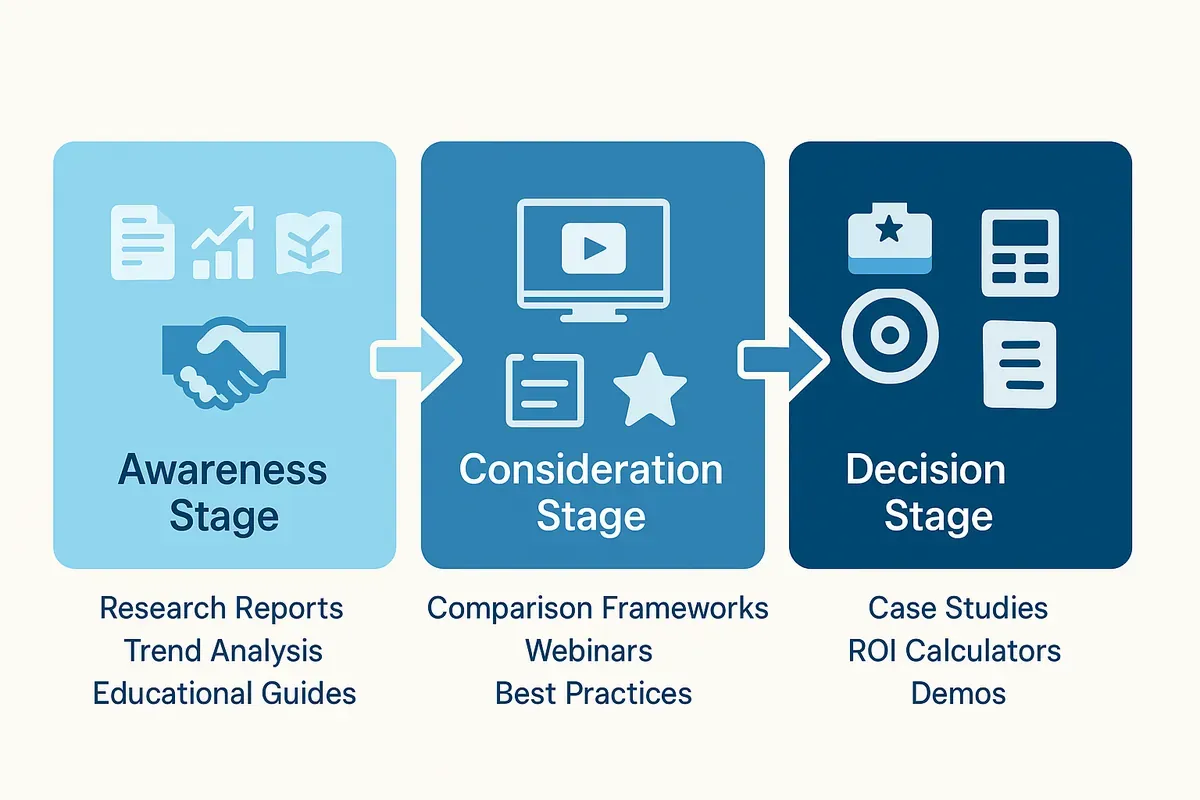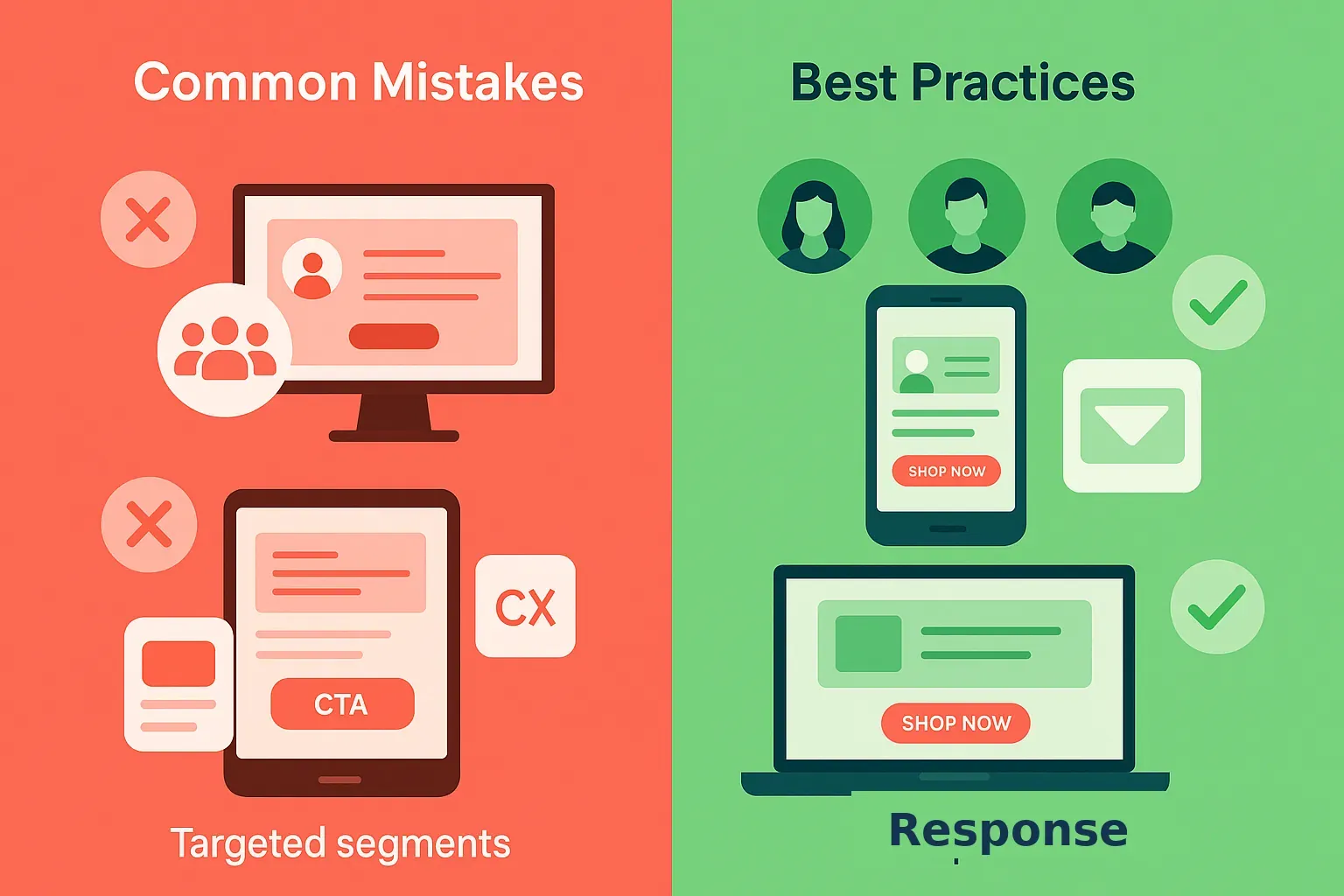Email Marketing for B2B: Building Relationships and Generating Leads
Master email marketing for B2B with proven strategies for lead generation. Complete guide covering segmentation, automation, content, and ROI measurement.

B2B companies face a persistent challenge: generating qualified leads through email marketing while building meaningful relationships with decision-makers. Unlike B2C campaigns that rely on impulse purchases, B2B email marketing requires longer nurture cycles, multiple stakeholder engagement, and sophisticated segmentation. Many B2B marketers struggle with low response rates and measuring ROI across extended sales cycles. This guide provides actionable strategies to transform your email marketing into a reliable lead generation engine.
TL;DR - Key Takeaways:
- Segmentation drives results: B2B campaigns with advanced segmentation generate 58% of all revenue, making audience targeting critical for success
- Nurture campaigns convert: Multi-touch email sequences produce 50% more sales-ready leads than single-touch approaches
- Personalization matters: B2B emails with personalized subject lines improve open rates by 26%
- Integration amplifies impact: Connecting email with CRM systems enables behavior-based triggers and better lead scoring
- Quality over quantity: Permission-based lists matching your ideal customer profile outperform large generic databases
What Is Email Marketing for B2B?
Quick Answer: Email marketing for B2B focuses on building relationships with business decision-makers through targeted, value-driven communication that guides prospects through longer sales cycles. Unlike B2C approaches, B2B email marketing emphasizes educational content, multi-stakeholder engagement, and demonstrating ROI to committees. The strategy requires sophisticated segmentation, lead nurturing sequences, and integration with sales processes to generate qualified leads effectively using email marketing for B2B channels.
B2B email operates differently from consumer campaigns. According to Gartner's B2B buying research, the typical buying group involves 6-10 decision-makers, each requiring different information at various stages. This complexity demands email strategies delivering value at each touchpoint.
💡 Pro Tip: B2B buyers conduct extensive independent research before engaging sales teams. Your email content should position your company as a trusted advisor through educational resources.

Building High-Quality B2B Email Lists
Quick Answer: Effective B2B email lists prioritize quality over quantity, emphasizing permission-based contacts matching your ideal customer profile. List-building strategies include gated content downloads, webinar registrations, free tools, and strategic partnerships. Successful email marketing for B2B maintains strict hygiene practices, removing inactive subscribers regularly and validating email addresses to protect sender reputation and ensure high deliverability rates.
Your email list quality directly impacts lead generation results. Start by defining your ideal customer profile—industry, company size, job titles, and pain points.
Strategic List-Building Tactics:
- Gated Content: Offer valuable resources (whitepapers, reports, templates) in exchange for contact information. Content Marketing Institute research shows 80% of B2B content marketing assets are gated.
- Webinars: Host educational sessions addressing industry challenges. Attendees self-qualify by demonstrating interest.
- Free Tools: Provide calculators or assessments delivering immediate value. Groupmail's AI subject line generator serves this purpose effectively.
- Strategic Partnerships: Co-market with complementary providers to access aligned audiences.
| List Building Method | Lead Quality | Conversion Rate |
|---|---|---|
| Gated Content | High | 15-25% |
| Webinars | Very High | 20-35% |
| Free Tools | Medium-High | 10-20% |
| Trade Shows | Medium | 5-15% |
Maintain list hygiene rigorously. Return Path's research shows email lists decay by 22.5% annually due to job changes. Implement double opt-in for higher engagement. Learn more about getting started with Groupmail for proper list management.
Segmentation Strategies That Drive Engagement
Quick Answer: B2B email segmentation divides audiences into targeted groups based on firmographic data (industry, company size), behavioral signals (website activity, email engagement), and buyer journey position. Advanced email marketing for B2B segmentation combining multiple criteria enables personalized messaging that resonates with specific decision-maker needs, resulting in 58% higher revenue from campaigns according to industry benchmarks.
Generic campaigns fail in B2B environments. Segmentation transforms broad messaging into targeted communication addressing specific pain points.
Essential Segmentation Criteria:
- Firmographic: Industry vertical, company size, geographic location, technology stack
- Behavioral: Website visits, email engagement, product interest signals, event participation
- Buyer Journey: Awareness, consideration, decision, customer stages
- Job Role: Technical buyers, business buyers, executives, influencers
💰 Business Impact: According to HubSpot's State of Marketing, personalized emails deliver 6x higher transaction rates than generic messages.
Groupmail's analytics dashboard enables detailed engagement tracking for effective segment refinement.
Creating Content That Educates and Converts
Quick Answer: High-performing B2B email content prioritizes education over promotion, addressing specific buyer pain points with actionable insights and industry expertise. Content should match the recipient's buyer journey position—awareness-stage emails focus on problem identification, consideration-stage emails compare solutions, and decision-stage emails provide proof points and case studies that facilitate committee approval and purchase decisions.
Content quality separates successful programs from ignored campaigns.
Content by Journey Stage:
Awareness: Industry trends, educational guides, research reports, thought leadership
Consideration: Solution comparisons, best practices, "how to choose" guides, webinars
Decision: Case studies, ROI calculators, product demos, customer testimonials
💰 Business Impact: B2B buyers receiving educational content are 131% more likely to purchase, according to Forrester research.
Use Groupmail's drag-and-drop editor to create professional templates maintaining brand consistency.

Automation and Nurture Sequences
Quick Answer: B2B email automation enables systematic lead nurturing through triggered sequences delivering relevant content based on prospect behavior and characteristics. Effective nurture campaigns span 7-13 emails over 30-90 days, combining educational content with gradual product introduction. Automated workflows should include lead scoring, welcome sequences, re-engagement campaigns, and post-purchase onboarding that increases customer lifetime value.
Manual campaigns can't scale effectively. According to Marketo research, companies implementing automation report 50% more sales-ready leads.
Essential Automation Workflows:
- Welcome Series (3-5 emails, 2 weeks): Value delivery, education, company positioning, social proof
- Lead Nurture (7-13 emails, 30-90 days): Progressive education through buyer journey with behavioral triggers
- Abandoned Action (3-4 emails, 1-2 weeks): Follow-up when prospects don't complete key actions
- Re-engagement (3-5 emails, 3-4 weeks): Target subscribers inactive 60-90 days
💡 Pro Tip: Implement lead scoring within automation. Assign points for opens, clicks, and downloads. When prospects reach threshold scores, trigger sales notifications.
Groupmail's unlimited sending enables comprehensive automation without per-email costs. SMTP integration capabilities ensure CRM synchronization.
Measuring Success and ROI
Quick Answer: B2B email marketing success extends beyond open and click rates to measure lead generation quality, sales pipeline contribution, and revenue attribution. Key performance indicators include MQL generation rates, SQL conversion percentages, cost per lead, pipeline velocity, and closed-won revenue influenced by email touchpoints. Advanced attribution models track email marketing for B2B's role across multi-touch customer journeys.
Measuring effectiveness requires alignment with sales outcomes. Business leaders care about pipeline generation and revenue influence, not just engagement metrics.
Tiered Measurement Framework:
Level 1 - Engagement: Open rate (15-25% benchmark), click-through rate (2-5%), conversion rate (1-3%)
Level 2 - Lead Generation: MQL volume, cost per MQL, lead-to-opportunity conversion
Level 3 - Revenue Impact: Pipeline value attributed, closed-won deals, customer acquisition cost
| Metric | B2B Benchmark | Strategic Value |
|---|---|---|
| Email-Sourced Pipeline | Varies by industry | Direct attribution |
| Cost per MQL | $50-$200 | Efficiency measure |
| Email ROI | 3,600% average | Executive communication |
💰 Business Impact: Companies tracking pipeline contribution demonstrate 3.1x higher growth rates than those measuring only engagement, per SiriusDecisions research.
Use Groupmail's campaign analytics to track detailed engagement patterns.
Deliverability Best Practices
Quick Answer: B2B email deliverability requires proper technical configuration including SPF, DKIM, and DMARC authentication records verifying sender legitimacy. Maintaining deliverability involves consistent sending patterns, engaged list hygiene, relevant content minimizing spam complaints, and monitoring sender reputation. Technical best practices include dedicated IP addresses for high-volume sending and following CAN-SPAM and GDPR regulations.
Even excellent content fails if emails don't reach inboxes. Return Path reports that 21% of permission-based emails fail to reach inboxes globally.
Critical Configurations:
- Authentication: SPF, DKIM, and DMARC protocols verify sender legitimacy
- Sender Reputation: Engagement rates, spam complaints (<0.1%), bounce rates (<2%)
- List Hygiene: Remove hard bounces immediately, address soft bounces after 3-5 occurrences
💡 Pro Tip: Warm up new IPs gradually. Start with engaged subscribers, increase volume 20-30% daily until reaching target capacity.
Compliance Requirements:
- CAN-SPAM (US): Accurate headers, physical address, functional unsubscribe
- GDPR (EU): Explicit consent, clear privacy notices
- CASL (Canada): Express or implied consent
Learn about SendGrid integration for authentication setup.
Common Mistakes and Solutions
Quick Answer: Common B2B email mistakes include insufficient segmentation, excessive send frequency causing fatigue, neglecting mobile optimization, failing to test variations, and treating email as isolated from broader strategy. Solutions involve implementing sophisticated segmentation, establishing frequency caps, designing mobile-first templates, conducting systematic A/B testing, and integrating email with CRM and sales processes.
Key Mistakes to Avoid:
Mistake 1 - Generic Campaigns: Sending identical messages to entire database
Solution: Implement segmentation based on industry, company size, and journey stage
Mistake 2 - Ignoring Mobile: Designing exclusively for desktop when 42% open on mobile per Litmus research
Solution: Use responsive templates, keep subject lines under 40 characters
Mistake 3 - Weak Subject Lines: Vague promotional subjects failing to convey value
Solution: Test benefit-oriented subjects using AI optimization tools
Mistake 4 - No Clear CTA: Multiple competing calls-to-action confusing recipients
Solution: Feature one primary CTA aligned with campaign objectives
Mistake 5 - Disconnected from Sales: Email operating independently from sales processes
Solution: Implement lead scoring triggering sales notifications at engagement thresholds

Key Terms:
- Marketing Qualified Lead (MQL): Prospect meeting qualification criteria but not ready for direct sales outreach
- Sales Qualified Lead (SQL): Lead accepted by sales as ready for direct engagement
- Lead Scoring: Methodology assigning values to behaviors and characteristics for prioritization
- Drip Campaign: Automated series sent on predetermined schedule for nurturing
- Segmentation: Dividing email lists into targeted groups by shared characteristics
- Deliverability Rate: Percentage of emails reaching inboxes rather than being blocked
- Progressive Profiling: Collecting information gradually through multiple interactions
- Multi-Touch Attribution: Tracking and crediting multiple touchpoints contributing to conversions
FAQ: B2B Email Marketing Questions
How often should I send email marketing for B2B campaigns?
Most B2B companies succeed with 1-4 emails monthly for general audiences, with higher frequency (weekly) for segmented nurture campaigns delivering high-value educational content. Monitor engagement and unsubscribe rates to calibrate frequency—reduce sending if engagement drops or unsubscribes increase.
What's the best time to send B2B marketing emails?
Tuesday through Thursday between 10-11 AM in recipient time zones generally performs well, as professionals have settled into work but haven't reached afternoon overload. However, optimal timing varies by industry and role. Test systematically with your audience segments.
Do B2B companies still get good ROI from email marketing?
Yes, email delivers $42 for every $1 spent according to DMA research. Email outperforms other channels because it enables direct decision-maker communication, facilitates long nurture cycles, and integrates with CRM systems for comprehensive tracking.
How do I improve B2B email deliverability?
Implement SPF, DKIM, and DMARC authentication, maintain engaged lists through regular hygiene, send relevant content minimizing spam complaints, and monitor sender reputation. Keep spam complaints below 0.1% and bounce rates under 2% for optimal inbox placement.
What subject line length works best?
B2B subject lines should stay between 40-50 characters for mobile visibility, which accounts for 42% of opens. However, relevance and specificity matter more than strict character counts. Test variations using tools like Groupmail's AI generator.
Is automation worth it for smaller B2B companies?
Absolutely. Automation delivers disproportionate value by enabling systematic nurturing without proportional resource increases. Even basic automation—welcome series, triggered follow-ups, re-engagement campaigns—dramatically improves conversion while reducing manual workload.
How should B2B differ from B2C email strategy?
B2B requires longer nurture cycles (30-180 days), multi-stakeholder consideration, more substantial educational content, and sales process integration. B2B emails contain more detailed copy, focus on ROI and business outcomes, and measure success through pipeline influence rather than immediate transactions.
What metrics matter most for B2B success?
While opens and clicks provide tactical feedback, success ultimately measures through pipeline contribution and revenue influence. Priority metrics include MQL generation volume and cost, lead-to-opportunity conversion rates, pipeline value attributed, and closed-won revenue influenced by campaigns.
Transform Your B2B Email Strategy
B2B email marketing remains highly effective for building relationships and generating qualified leads—when executed strategically. Success comes from sophisticated segmentation, value-driven content, systematic automation, and measurement focused on business outcomes.
Start by auditing your approach against these frameworks. Identify gaps in segmentation, content relevance, or technical infrastructure. Prioritize improvements addressing your primary challenges—whether low engagement, poor deliverability, or weak pipeline contribution.
Companies generating consistent leads through email share common characteristics: they deliver genuine value, leverage data for relevant personalization, integrate email with sales processes, and measure what matters—pipeline and revenue contribution.
Ready to implement these strategies? Start with Groupmail's free account—no credit card required. Access unlimited sending, sophisticated segmentation, automation workflows, and comprehensive analytics designed for B2B marketers who need to demonstrate ROI. Explore Groupmail's features to see how the platform supports strategic email marketing driving measurable business results.




